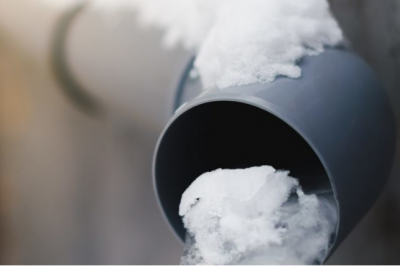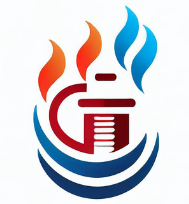All condensing gas boilers produce condensate as a waste product. There are a number of options available to the installer of how to dispose of this condensate, with some being easier for them to install while others are easier for you as the customer to manage. We show you three easy ways to fix a frozen condensate pipe.
How to thaw a frozen boiler condensate pipe
When you notice the condensate pipe frozen, thaw it using one of three methods. First, pour warm water near the bottom of the pipe. If that doesn’t clear it, place a hot water bottle on a section of the pipe to thaw the ice. You can also use a heat wrap around the pipe which should clear any blockage.

During the cold winter months, external condensate pipes are at risk of freezing, and this can potentially cause a problem with your boiler and making it switch off as a safety precaution. This is obviously not needed any time, but especially in winter when it is more difficult to get hold of an engineer to fix the issue.
What is a Condensate Pipe and Where is it Located?
A condensate pipe carries away waste water produced as a byproduct of high-efficiency gas condensing boilers. When natural gas is burned for heat, water vapor is a result. As this vapor cools in the boiler, it condenses back into liquid water that needs draining.
The condensate pipe is usually a white or gray plastic tube measuring around 22mm in diameter. It runs from the boiler to a drainage point, passing through the wall directly outside where the boiler itself is located.
| Location | Details |
|---|---|
| Inside home | May run through floorboards or attic |
| Outside home | Exits from boiler out through wall |
| Drainage point | Connects to household drain, external drain, or soakaway pit |
During cold weather, any sections exposed to freezing temperatures are at risk of ice blockages that can disable the boiler. Knowing where your condensate pipe runs and having it properly insulated and protected are key to preventing freezing.
Finding the condensate pipe in your home can be a bit tricky, especially if you’re not familiar with your heating system. The easiest way to locate the condensate pipe is to follow the white plastic pipe that comes out of your boiler.
Where can condensate pipes freeze?
Condensate pipes that run externally leave it vulnerable to be frozen in extremely cold temperatures. Pipes that run through wall cavities or outbuildings such as garages that are unheated are also at higher risk of freezing. If you run your hand along the pipe externally, the coldest part will likely be where it’s blocked.
A frozen condensate pipe in a boiler can occur due to cold weather conditions, particularly during the winter months. Here are some causes and potential consequences of a frozen condensate pipe:
Causes:
- Low temperatures: When the external temperature drops below freezing point, the condensate pipe is at risk of freezing. This pipe carries the waste water produced by the boiler, and if the water freezes, it can block the pipe.
- Insufficient insulation: Inadequate insulation around the condensate pipe can make it more susceptible to freezing. Lack of proper insulation allows the cold temperatures to penetrate the pipe, leading to the formation of ice.
Potential Consequences:
Boiler shutdown: When the condensate pipe freezes, the trapped water cannot be removed, causing a backup. As a safety precaution, the boiler may automatically shut down to prevent any damage or further issues.
Loss of heating and hot water: Since the boiler is unable to remove the waste water, it disrupts the normal functioning of the heating system, resulting in a lack of heating and hot water in the building.
Gurgling or bubbling noises: The trapped water inside the frozen pipe may create gurgling or bubbling sounds. These noises indicate that the water is unable to escape, causing pressure and disturbances within the system.
Fault codes and error messages: Many boilers are equipped with error code systems that help diagnose issues. In the case of a frozen condensate pipe, the boiler may display a fault code indicating the problem.
Step-by-Step Instructions for Thawing a Frozen Condensate Pipe
When trying to thaw a frozen condensate pipe, follow these steps:
- Locate the condensate pipe. This is usually a white plastic pipe connected to your boiler and running outside. Follow it visually from your boiler through the wall to identify it.
- Find where the blockage is. Run your hands along the exposed parts of the pipe to feel for the coldest section. This is likely where it is frozen. Focus on areas like elbow joints or near the ground.
- Use warm, not boiling, water. Boil some water first, but let it sit for 15+ minutes to cool down before using. Slowly pour the warm water along the frozen section. The warm water will help melt the ice gradually without damaging the pipe.
- Repeat as needed. It may take several rounds of pouring warm water to fully thaw the pipe. Give it time between rounds to work. You should see ice melting and hear gurgling as the blockage clears.
- Check your boiler’s manual for proper reset instructions once the pipe is thawed. Then restart your boiler.
Take safety precautions like wearing gloves and watch your footing when pouring the warm water. Never use boiling water directly from a kettle as it can crack the plastic pipe. If you cannot get the pipe thawed after several attempts, call a professional for assistance.
How do I know if I have a condensing boiler?
Condensing boilers usually have a plastic flue terminal outside of the property. When the boiler is on, there is likely to be white steam coming out of the flue, depending on the outside temperatures. Condensing boilers will also have a plastic pipe coming out of the boiler to allow waste water to be drained away.
Tools to help protect against frozen pipes
- Frost Protect Freezing Condensate Pipe – Condenser Boiler – Heat Trace Cable Kit
- Foam Pipe Insulation
- Condensate Pro Connection Kit for Frozen Condensate Pipe Insulation
Ways to thaw a frozen boiler condensate pipe
When it comes to thawing a frozen condensate pipe, there are some troubleshooting tips and common mistakes to keep in mind. Here are a few suggestions:
Patience is key
hawing a frozen condensate pipe may take some time, so it’s important to be patient and avoid rushing the process. Rapid temperature changes or excessive force can potentially damage the pipe.
Gradual warming
Instead of using boiling water, which can be too hot and cause the pipe to crack, opt for warm water. Pour the warm water near the bottom of the pipe and allow it to slowly thaw the ice. Repeat this process if needed, giving it time to work.
Hot water bottle method
Placing a hot water bottle on the affected section of the pipe can help thaw the ice. Leave the hot water bottle in place until the pipe is clear and water starts trickling out again. This method provides a consistent source of gentle heat.
Heat wrap usage: Heat wraps designed for frozen pipes can also be effective. These wraps provide controlled heat and can be wrapped around the pipe to thaw the blockage. Follow the manufacturer’s instructions for proper usage.
Avoid excessive heat sources: While it may be tempting to use a heat gun or other high-temperature devices, it’s best to avoid excessive heat sources. Direct exposure to high temperatures can damage the pipe or other components of the boiler system.
Safety precautions: Always prioritize your safety when attempting to thaw a frozen condensate pipe. Wear appropriate protective gear and use caution when working around the boiler and pipe. If you’re unsure or uncomfortable with the process, it’s recommended to consult a professional heating engineer.
Signs Your Condensate Pipe is Frozen
When a condensate pipe freezes, it can cause noticeable symptoms with your boiler system. Watch for these warning signs:
- Lack of heat or hot water – Since a frozen pipe blocks normal drainage, condensate water backs up and the boiler shuts down as a safety precaution. This results in interrupted heating and hot water.
- Gurgling or bubbling noises – The backed-up condensate in a blocked pipe can make gurgling or bubbling sounds as pressure builds up. This is especially noticeable near the location of the frozen blockage.
- Fault codes on boiler display – Many modern gas boilers have digital display panels. Error codes like E133, E225, or E228 indicate issues sensing water flow and likely point to a frozen condensate line.
- Water buildup around boiler – You may notice water pooling around the base of the boiler as the condensate has nowhere to drain. This is a red flag for pipe blockage.
- Ice or frost buildup on pipe – Visually inspecting the condensate pipe may reveal obvious ice or frost in the areas where it has frozen over and become blocked.
Taking quick action when you observe these warning signs can help get your boiler back up and running. The sooner you are able to diagnose a frozen condensate pipe and thaw it safely, the faster you can restore normal heating system function. If boiler issues persist even after attempting to thaw the pipe, contact a Gas Safe registered engineer for assistance.
Fault codes on a boiler may indicate a frozen condensate pipe
When a frozen condensate pipe is bad enough for the boiler to stop working, it will display a fault code. Before calling a repairman, check the code in the user manual to see if it’s a condensate pipe problem, it is usually listed. You can also download most of these manuals online.
Tips for Preventing Future Condensate Pipe Freezing
Once you’ve dealt with a frozen condensate pipe, it’s a good idea to take steps to prevent it from happening again in the future. Here are some tips:
- Insulate exposed pipes. Use foam pipe insulation designed for exterior use to wrap any sections of the condensate pipe that are exposed to freezing temperatures. The insulation adds a protective barrier against the cold. Make sure to check the pipe diameter and get the right size insulation.
- Increase pipe slope. Having more vertical drop on the pipe gives the condensate water better drainage flow so it doesn’t pool and freeze as easily. A qualified boiler specialist can adjust the pipe slope if needed.
- Reroute drainage. If possible, see if the condensate drainage can be re-routed to an interior connection like a sink or washing machine drain pipe. This keeps the entire run of the pipe inside and away from exterior freezing risks.
- Enclose drainage point. Add an enclosure or cover around the open end of the pipe at its drainage point. This helps block wind chill and precipitation from direct contact with the condensate discharge.
- Turn up boiler temperature. Temporarily adjusting your boiler’s thermostat to the highest possible temperature can help reduce condensation buildup during extreme cold. Just remember to turn it back down after the cold snap passes.
- Check antifreeze level. Some condensate pipes have a water traps that use antifreeze. Make sure this antifreeze is filled to the proper level for cold weather protection.
Taking preventative measures can save you the hassle of dealing with frozen pipes down the road. A qualified heating engineer can advise you on the best solutions for your unique condensate pipe setup. Taking steps to prevent freezing before it occurs is always preferable to reactively thawing a blocked pipe.
Read related articles
